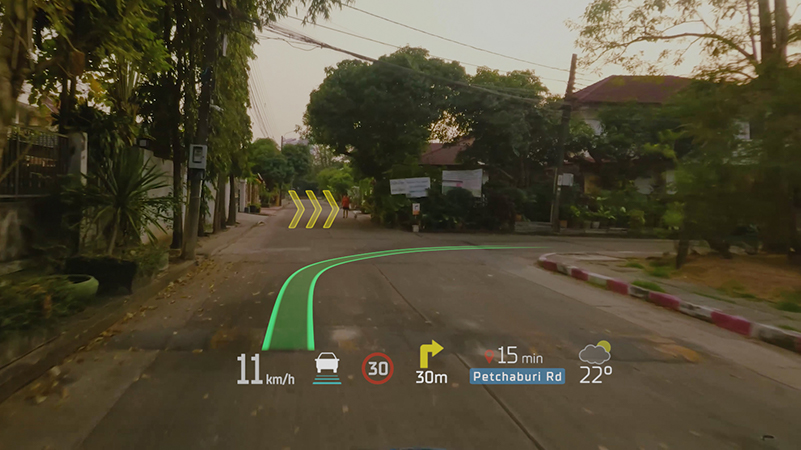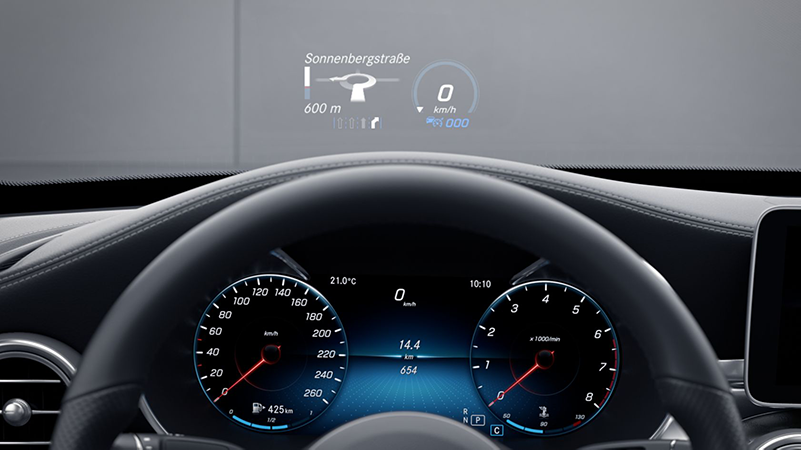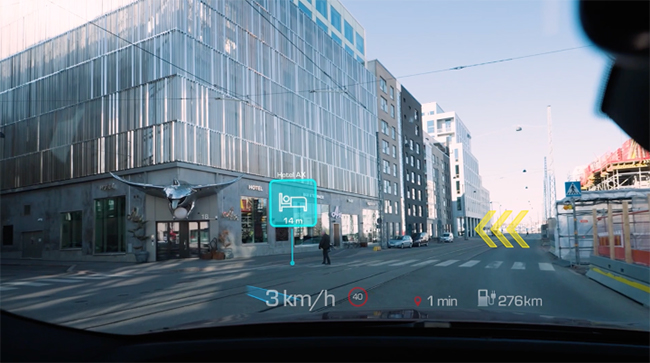
Automotive heads up displays (HUD) have allowed drivers to get useful information displayed directly in their line of sight on the windshield. Ultimately reducing the need for the driver to focus between different screens in the vehicle. New-generation HUDs, so called Augmented Reality heads up displays (AR HUD), are entering the market, taking the HUD experience one step further. In this article, we will further explore the advantages of AR HUDs.
Heads Up Displays Today and Past
The most common type of HUDs found in vehicles today are 2D HUDs which can project 2-dimensional content onto the vehicle’s windshield. Typically, only a limited amount of information can be displayed on 2D HUD, such as, current speed, speed limits, and navigation maps etc. Some 2D HUD projections may appear somewhat bulky, causing the projected content to seem unnatural and poorly integrated with the windshield and the surrounding environment. In fact, some projected content might resemble the look and feel of projectors often used by teachers and lecturers in the 1990s or early 2000s.

Example of a 2D HUD application by Mercedes-Benz.
Nevertheless, the automotive HUD technology has rapidly improved, and consumers truly value the technology due to its convenience. Consequently, the demand for HUDs is expected to increase. According to Mordor Intelligence, the HUD market was estimated to be around 1,27 billion US dollars in 2021 and is expecting to reach over 4,56 billion US dollars in 2027, registering an CAGR of 24% for the period.
While the HUD market is growing fast, so does the HUD technology, new forms of HUDs are entering the market, such as the AR HUD.
What Are AR Heads Up Displays and What Do They Do?
The AR HUD is the next step in the evolution of the HUD. What makes AR HUDs unique is their ability to project content in 3D, allowing for a more seamless merging of virtual content onto the real world. Unlike traditional HUDs which have a very short virtual image distance that requires the driver to constantly shift focus between near and far objects, AR HUDs can project content at a much higher virtual image distance. This feels more natural and comfortable for the driver, enabling them to simultaneously focus on the road and AR content at the same time.

As the image shows, you can see how the AR HUD augments reality, and seamlessly blends into the environment around the vehicle.
In addition, with AR HUDs you can project a wider range of information compared to the traditional HUDs, such as various advanced driver assistance features, like adaptive driving assistance, lane guidance, object detection, and collision warnings etc. By projecting these virtual elements in real-time, AR HUDs provide drivers with critical information about the surroundings, potential hazards, and additionally, navigation instructions in a more convenient and intuitive manner.
One of the key advantages of AR HUDs is their ability to display information in the context of the current driving situation and merging the information with the real-world environment. For example, navigation instructions can be overlaid onto the road ahead, highlighting the correct turns or exits in the field of view of the driver. This approach enhances the driver’s understanding of directions, reduces the cognitive load of interpreting GPS maps, improving overall driving safety.
In What Way AR HUDs Are Useful to Drivers?
AR HUDs offer several significant advantages to drivers, making them highly useful in enhancing the overall driving experience and improving driver safety. Here are some key reasons why AR HUDs are valuable for drivers:
- Enhanced Safety: One of the primary advantages of AR HUDs is their ability to improve safety on the road. By projecting or reflecting critical information directly in the driver’s line of sight, AR HUDs eliminate the need for drivers to look away or shift focus to check instrument panels or infotainment screens. This allows drivers to keep their eyes focused on the road without having to divert their attention away from the road. This helps maintain better focus and concentration while driving.
- Improved Situational Awareness: AR HUDs provide drivers with real-time information about the surroundings, such as, detection of pedestrians, objects and other vehicles. By having this information readily available in front of their eyes, drivers can maintain better situational awareness, making informed decisions based on the current road conditions, traffic, and other relevant factors. This, in turn, contributes to safer and more efficient driving.
- Seamless Navigation Assistance: AR HUDs can integrate with navigation systems to provide turn-by-turn directions, upcoming road names, and distance to the next maneuver, all displayed directly on the windshield. This feature allows drivers to keep their eyes on the road while receiving visual cues for navigation, reducing the chances of missing crucial directions, and improving overall navigation accuracy.
- Integration with Advanced Driver Assistance Systems (ADAS): AR HUDs can seamlessly integrate with ADAS technologies, such as lane departure warning systems, collision avoidance systems, and adaptive cruise control. By displaying real-time alerts and warnings directly in the driver’s field of view, AR HUDs enhance the effectiveness of these safety features, enabling drivers to respond quickly to potential hazards.
What Are the Challenges Faced in the Widespread Adoption of AR HUDs?
While AR HUDs offer clear benefits in enhancing the driver experience and driving intuitiveness, there are factors to be mindful of that might influence widespread adoption.
- Cost and Accessibility: AR HUD technology can be costly to develop and implement, which can limit its availability in lower-priced vehicles. The cost of the necessary hardware components, such as high-resolution displays, sensors, and advanced processing units, adds to the overall expense. Making AR HUDs more affordable and accessible for a wider range of vehicles remains a challenge.
- Technological Limitations: AR HUDs require advanced hardware and software integration to provide real-time and accurate information overlay. Achieving a seamless and stable content, with minimal latency and precise tracking of the driver’s perspective, can be technically challenging. Addressing these limitations requires continuous advancements in display technology, sensors, and processing capabilities.
- Distracting: As mentioned, one of the great advantages with HUDs is its ability to reduce driver distraction by displaying information directly in the driver’s line of sight. However, contrary, if too much content is displayed on the windshield, it will distract and confuse the driver. To ensure an immersive experience, you have to ensure that the right content is displayed at the right time and place. Overlapping virtual content with the real-world environment requires careful consideration of what content, colors, contrasts, and sizes to maintain clarity and prevent cognitive overload. Striking the right balance between informative and unobtrusive visuals is crucial for successful adoption.
- Safety and Regulations: At the moment, there are no clear safety regulations that dictate how and what information should be displayed on an AR HUD. However, since you are displaying information on one of the most critical parts of the vehicle, the windshield, it is accurate to assume that in the future (very soon), there will be regulations that automotive OEMs need to follow.
- User Acceptance and Adaptation: Introducing AR HUDs into the mainstream requires drivers to adapt to new display technologies and interact with augmented information while driving. Driver acceptance, understanding, and comfort with AR HUDs play a significant role in their widespread adoption. Effective user training, education, and user interface design are critical to ensure a seamless transition and acceptance of this technology.
Paving the Way for Safer and More Intuitive Driving
AR HUDs offer the automotive industry a compelling and innovative technology that seamlessly integrates virtual information with the real world, enhancing driver safety and convenience.
However, the widespread adoption of AR HUDs faces challenges related to cost, technological complexities, user acceptance, and adaptation. Overcoming these obstacles will require addressing affordability, improving display stability and responsiveness, ensuring user-friendly interfaces, and educating drivers about the benefits and safe use of AR HUDs.
But despite these challenges, the future of AR HUDs holds great promise, as advancements in technology and collaboration among stakeholders pave the way for a future where AR HUDs become a standard feature, transforming the driving experience, and making roads safer.

